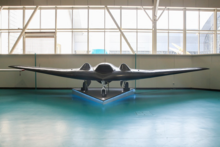| Shahed 171 Simorgh | |
|---|---|
 | |
| Role | Multirole [1] |
| National origin | Iran |
| Manufacturer | Shahed Aviation Industries |
| First flight | 2014 [2] |
| Status | Active |
| Primary user | IRGC AF |
| Produced | 2010s–present |
| Developed from | RQ-170 Sentinel |
The Shahed 171 Simorgh (sometimes S-171 and called IRN-170 by the US government [1] ) is an Iranian jet-powered flying wing unmanned combat aerial vehicle (UCAV) produced by Shahed Aviation Industries. [3]
Contents
- Etymology
- Design
- Status
- Operators
- See also
- Related development
- Aircraft of comparable role, configuration and era
- References
Its design is based on a reverse engineered American RQ-170 UAV captured by Iran in 2011 and modified to carry guided missiles. [3] It is one of two Iranian flying wing UAVs based on the RQ-170, along with the Saegheh, a smaller version, with which it is often confused.

